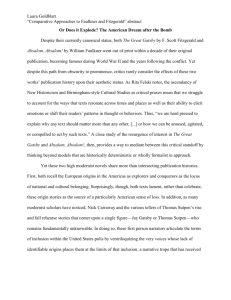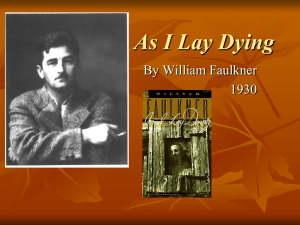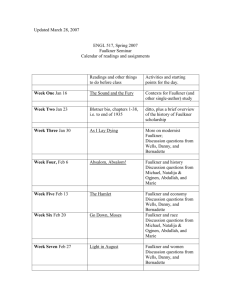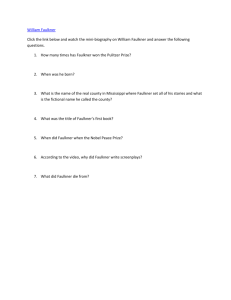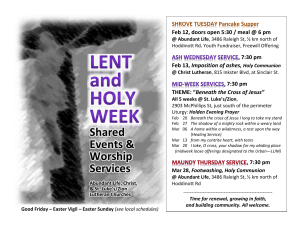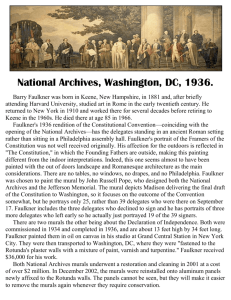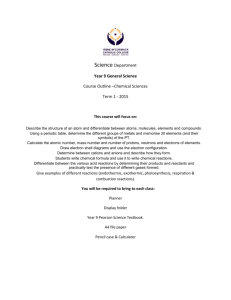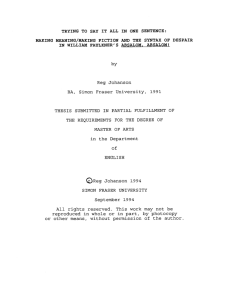English 482: William Faulkner
advertisement
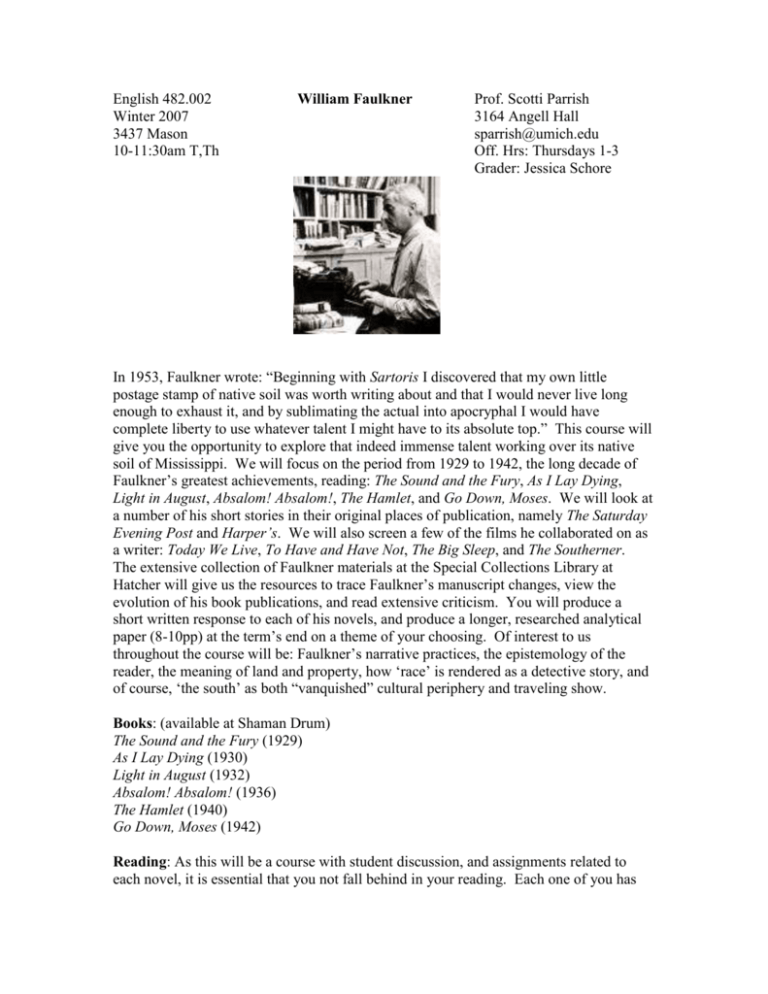
English 482.002 Winter 2007 3437 Mason 10-11:30am T,Th William Faulkner Prof. Scotti Parrish 3164 Angell Hall sparrish@umich.edu Off. Hrs: Thursdays 1-3 Grader: Jessica Schore In 1953, Faulkner wrote: “Beginning with Sartoris I discovered that my own little postage stamp of native soil was worth writing about and that I would never live long enough to exhaust it, and by sublimating the actual into apocryphal I would have complete liberty to use whatever talent I might have to its absolute top.” This course will give you the opportunity to explore that indeed immense talent working over its native soil of Mississippi. We will focus on the period from 1929 to 1942, the long decade of Faulkner’s greatest achievements, reading: The Sound and the Fury, As I Lay Dying, Light in August, Absalom! Absalom!, The Hamlet, and Go Down, Moses. We will look at a number of his short stories in their original places of publication, namely The Saturday Evening Post and Harper’s. We will also screen a few of the films he collaborated on as a writer: Today We Live, To Have and Have Not, The Big Sleep, and The Southerner. The extensive collection of Faulkner materials at the Special Collections Library at Hatcher will give us the resources to trace Faulkner’s manuscript changes, view the evolution of his book publications, and read extensive criticism. You will produce a short written response to each of his novels, and produce a longer, researched analytical paper (8-10pp) at the term’s end on a theme of your choosing. Of interest to us throughout the course will be: Faulkner’s narrative practices, the epistemology of the reader, the meaning of land and property, how ‘race’ is rendered as a detective story, and of course, ‘the south’ as both “vanquished” cultural periphery and traveling show. Books: (available at Shaman Drum) The Sound and the Fury (1929) As I Lay Dying (1930) Light in August (1932) Absalom! Absalom! (1936) The Hamlet (1940) Go Down, Moses (1942) Reading: As this will be a course with student discussion, and assignments related to each novel, it is essential that you not fall behind in your reading. Each one of you has his/her own way of raising your reading from the level of relatively passive plotfollowing to a more engaged analysis in which you produce multi-leveled meaning; for some this is taking notes; for others, creating ‘keys’ in the back of your book; for still others, flagging key passages that you read a number of times. Whatever your system, you should perform that kind of reading before class each day; you should have something to say if I ask you: “what did you think?” Faulkner produces more questions than he answers, so you can bring in a series of questions rather than feel like you already need to have definitive answers. Attendance and Participation: Any absences beyond two unexcused absences will count against your grade. You can participate in large discussions, small groups, and/or come to office hours to talk. All participation will be remembered and will help your grade; moreover, it helps YOU hone your thoughts and become a more articulate adult. Small Papers: For each novel, you will produce a short written response. For S&F, it will be a close reading of a passage that I will determine. It will be no more than 2pp. I will decide the other assignments as we go, but one will deal with Faulkner’s revision process; one will respond to scholarly criticism; one will involve applying some narrative theory to a text; one will probably deal with the issues of historical memory and another with racial construction. We will see what you are interested in! My hope is that these small papers will allow you to build gradually and variously a collection of ideas, and different kinds of knowledge about Faulkner’s works. They will allow you to try out different approaches, and broaden your own analytical methods. By the time you turn to conceiving of your final paper topic, you will have a number of different tools at your disposal. Final Paper: This will be an 8-10pp paper due three days after the final class. In it I will expect you to use two secondary sources (criticism or theory). It may be about just one novel or it may trace a theme through a number of novels. You will need to check in with me about the topic a few weeks before due date. The goal of this paper is for you to: look deeply into a text or into an issue; make up your own questions; become an expert on some dimension of Faulkner’s meaning-making practice; produce an original reading based upon solid evidence; write beautifully and with verve. Plagiarism: It’s wrong because you steal intellectual property; you are an idea or a word thief; moreover, you cheat yourself out of learning something. Don’t use another’s words or ideas without specific citation. I have sent people to the Dean’s office when this has occurred in previous classes; in other words, I take this issue seriously. Grade: To arrive at a base grade, I will count your small papers as 60% and your large paper as 40% of that grade. I will then account for participation and attendance and adjust accordingly. Class Trip to Special Collections Library to see Faulkner collection! Syllabus: Jan 4 Introductions; close reading of opening of S&F Jan 9 The Sound & the Fury: Benjy’s section Jan 11 The Sound & the Fury: Quentin’s section Jan 16 The Sound & the Fury: Jason’s section Jan 18 Jan 19 The Sound & the Fury: Dilsey’s section 2pp paper due 3pm under my office door Jan 23 As I Lay Dying: to 99 Jan 25 As I Lay Dying: to 176 Jan 30 As I Lay Dying: to 261 Feb 1 Feb 2 Light in August: to 118 (through Chapter 5) A I L D diagram project under door by 3 Feb 6 Light in August: to 200 (through Chapter 8) Feb 8 Light in August: to 319 (through Chapter 13) Feb 13 Light in August: to 392 (through Chapter 16) Feb 15 Light in August: to 507 (the end!) Feb 20 3pp LIA project due in class: an analytical paper on some issue of racial construction/ representation in the novel; discuss papers in small groups and show the 1965 documentary, William Faulkner’s Mississippi, in class Feb 22 Absalom! Absalom!: to 70 (through Chapter 3) Feb 27 VACATION Mar 1 VACATION Mar 6 Absalom! Absalom!: to 176 (through Chapter 6) Mar 8 Mar 12 Absalom! Absalom!: to end A!A! project due at 3pm in my office Mar 13 The Hamlet: “Flem” Mar 15 The Hamlet: “Eula” Mar 20 The Hamlet: “The Long Summer” Mar 22 Mar 23 The Hamlet: “The Peasants” The Hamlet response due in my office by 5pm Mar 27 Go Down, Moses: Saturday Evening Post version of “The Bear” Mar 29 Go Down, Moses: “The Bear” April 3 Go Down, Moses: “The Bear” April 5 Film Screening in class; be working on final paper April 10 Film Screening in class; be working on final paper April 12 Discuss films and large themes of course April 17 Bring in rough draft of final paper; small group work April 20 3pm final paper due under my office door Assignment #2: diagramming As I Lay Dying The point of all these short assignments is to break down the multi-faceted process of understanding a work of literature and creating a thoughtful, polished analytical paper. Last week we practiced close reading; in theory, by making yourself aware of how closely you can read a single passage, ALL of your reading becomes more intense and nuanced. A different way to gain knowledge about a text—instead of applying a microscope to one passage in a close reading—is to telescope out in order to understand the thematic or behavioral geography of an entire text. In this exercise, you supply the particular theme or action whose movement you want to trace and map over the course of the book. One theme could be narrative perspectives; you’d map or diagram who tells the story, when, how many times, etc. Other categories could be: animals, or injuries, or financial transactions, or labors performed. In a paper, if you were to write about a theme, you would want to isolate the moments of its appearance, in order to look at the development of that theme/action in a kind of high relief. This assignment, therefore, will help you practice that stage of abstraction because it is easy to get lost in the thicket of books; sometimes too, students think they are abstracting a narrative when they are only giving plot summary; so we’ll work on refining this distinction. You can create your diagram/map by hand or on the computer; keep it all on one page though; on the bottom, or on an attached sheet of paper, explain in just a sentence or two what your diagram/map showed you about the novel. Due Friday at 3pm in my office. I Want To Vanish I want to vanish This is my fondest wish To go where I cannot be captured laid on a decorated dish Even in splendour this curious fate Is more than I care to surrender Now it’s too late Whether in wonder or indecent haste You arrange the mirrors and the spools To snare the rare and precious jewels That were only made of paste If you should stumble upon my last remark I’m crying in the wilderness I’m trying my best to make it dark How can I tell you I’m rarer than most I’m certain as a lost dog pondering a sign post I want to vanish This is my last request I’ve given you the awful truth Now give me my rest Elvis Costello, from All This Useless Beauty (1996)

